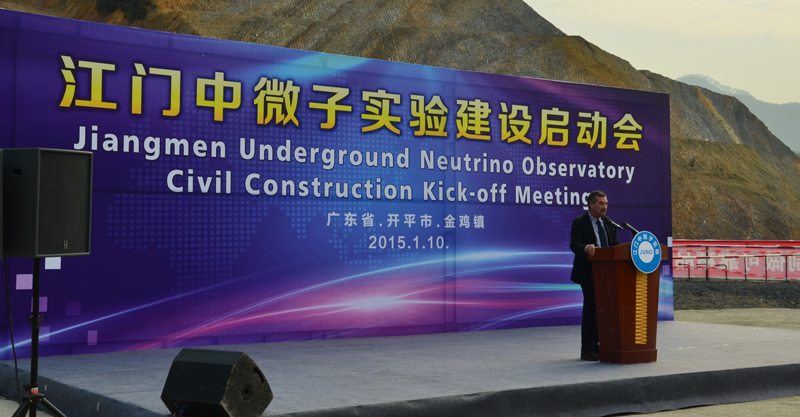 On 10 January in Jiangmen, a city in the province of Guangdong, China, the excavation works began for the construction of the Jiangmen Underground Neutrino Observatory (JUNO): a gigantic international experiment for the study of neutrinos. JUNO, together with HYPER-KAMIOKANDE in Japan and ELBNF in the USA, will be one of the three big neutrino detectors to be built in the coming years. In particular, JUNO will be an underground liquid scintillator neutrino detector and will exploit a technology similar to that used at the INFN National Laboratories of Gran Sasso for the Borexino experiment. According to the plan, the experiment will start to acquire data in 2020 and should remain in operation for 20 years. JUNO will investigate a crucial parameter of neutrino physics: the way in which nature has ordered the masses. We know that neutrinos can be of three types called electron, muon and tau and that they can mutate (process called oscillation) and transform themselves from one type to another. The experiment will study neutrinos produced and "sent" by two nuclear complexes situated 52 km away from the detector, comprising a total of 10 reactors. The international collaboration includes forty-five scientific institutions from eleven countries: in addition to China and Italy, it counts Armenia, Belgium, France, Finland, Germany, Czech Republic, Russia, the United States and Taiwan. Internationality is a key aspect of the JUNO project which involves scientists from all around the world in the construction of the device. Italy, with the National Institute for Nuclear Physics, has a prominent role and INFN physicists are engaged in crucial areas, such as purification of the scintillator, electronics, plastic scintillators, data acquisition, analysis and simulation, study of geo-neutrinos and evaluation of the operation mode of the reactors that generate the neutrinos used in the experiment. The study of neutrino oscillations is one of the most promising frontiers of contemporary physics. Currently, the T2K experiment in Japan and the NOVA experiment in the US are in the data acquisition phase and from them, in the coming years, some preliminary indication on the neutrinos masses ordering is expected. In addition to JUNO, the ORCA experiment in the Mediterranean Sea and the PINGU experiment at the South Pole, which will study the effects of the interaction of neutrinos of atmospheric origin with matter, are in the design phase. Atmospheric neutrinos are also the subject of the INO experiment to be realized in an underground laboratory in India. After JUNO, two giant argon and water detectors will arrive: ELBNF and HYPER-KAMIOKANDE. The first will confirm with very high precision the ordering of the masses that JUNO at that time should have already determined, and will also measure an additional physical parameter called “CP violation phase” on which the Japanese HYPER-KAMIOKANDE will focus. As of today, physicists assume that when all these experiments will have completed their programmes, between 2035 and 2040, the study of neutrino oscillations will be finally completed even in its most complex details.
On 10 January in Jiangmen, a city in the province of Guangdong, China, the excavation works began for the construction of the Jiangmen Underground Neutrino Observatory (JUNO): a gigantic international experiment for the study of neutrinos. JUNO, together with HYPER-KAMIOKANDE in Japan and ELBNF in the USA, will be one of the three big neutrino detectors to be built in the coming years. In particular, JUNO will be an underground liquid scintillator neutrino detector and will exploit a technology similar to that used at the INFN National Laboratories of Gran Sasso for the Borexino experiment. According to the plan, the experiment will start to acquire data in 2020 and should remain in operation for 20 years. JUNO will investigate a crucial parameter of neutrino physics: the way in which nature has ordered the masses. We know that neutrinos can be of three types called electron, muon and tau and that they can mutate (process called oscillation) and transform themselves from one type to another. The experiment will study neutrinos produced and "sent" by two nuclear complexes situated 52 km away from the detector, comprising a total of 10 reactors. The international collaboration includes forty-five scientific institutions from eleven countries: in addition to China and Italy, it counts Armenia, Belgium, France, Finland, Germany, Czech Republic, Russia, the United States and Taiwan. Internationality is a key aspect of the JUNO project which involves scientists from all around the world in the construction of the device. Italy, with the National Institute for Nuclear Physics, has a prominent role and INFN physicists are engaged in crucial areas, such as purification of the scintillator, electronics, plastic scintillators, data acquisition, analysis and simulation, study of geo-neutrinos and evaluation of the operation mode of the reactors that generate the neutrinos used in the experiment. The study of neutrino oscillations is one of the most promising frontiers of contemporary physics. Currently, the T2K experiment in Japan and the NOVA experiment in the US are in the data acquisition phase and from them, in the coming years, some preliminary indication on the neutrinos masses ordering is expected. In addition to JUNO, the ORCA experiment in the Mediterranean Sea and the PINGU experiment at the South Pole, which will study the effects of the interaction of neutrinos of atmospheric origin with matter, are in the design phase. Atmospheric neutrinos are also the subject of the INO experiment to be realized in an underground laboratory in India. After JUNO, two giant argon and water detectors will arrive: ELBNF and HYPER-KAMIOKANDE. The first will confirm with very high precision the ordering of the masses that JUNO at that time should have already determined, and will also measure an additional physical parameter called “CP violation phase” on which the Japanese HYPER-KAMIOKANDE will focus. As of today, physicists assume that when all these experiments will have completed their programmes, between 2035 and 2040, the study of neutrino oscillations will be finally completed even in its most complex details.






